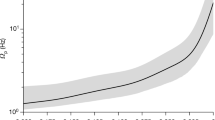Abstract
The theory of gravity says that a binary with orbital frequency ν should be a source of gravitational waves at the double frequency and higher harmonics. This implies that long-term exposure of an ensemble of binaries to gravity waves with frequency ν G can result in (a) a lack of binaries with frequencies near frequency ν G /2 and its higher harmonics (the effect of unstable orbits) and/or (b) an excess of binaries whose orbital frequencies are “absolutely” incommensurable with ν G /2 and its higher harmonics (the effect of stable orbits). It is assumed that the stable-orbit frequencies are almost equal to multiples of πν G /2 and ν G /2π, where π plays the role of a “perfect” factor ensuring the best antiresonance of binaries. The statistical analysis of frequencies of 5774 Galactic close binary systems (CBSs) with periods P less than 10 days is based on calculating the resonance spectrum that indicates the best common multiple for a given set of frequencies with allowance for the factor π. The CBS distribution turns out to be modulated by the frequency ν G = 104.4(5) μHz, and this effect is the most pronounced for superfast and compact rotators, such as cataclysmic variables (CVs) and related objects. The frequency ν G is, within the error, equal to the “enigmatic” frequency ν0 = 104.160(1) μHz com discovered earlier in the power spectra of the Sun and brightness variations of some extragalactic sources. This confirms the existence of a “coherent cosmic oscillation” of the Universe with frequency ν0(ν G ). The new astrophysical phenomenon naturally explains an “CV period gap” at frequencies ≈πν G /3 (P ≈ 153 min) and maxima at the neighboring frequencies ≈πν G /2 and ≈πν G /4 (P ≈ 102 and ≈204 min, respectively). The remarkable and “mysterious” role of the transcendental number π for the world of binaries is emphasized, and the mystery of physical nature of the “universal” oscillation ν0(ν G ) is highlighted.
Similar content being viewed by others
References
V. F. Asmus, The Great Soviet Encyclopedia, Vol. 11 (Sov. Encyclop., Moscow, 1973), p. 992 [in Russian].
A. V. Belinskii, Phys. Usp. 40, 305 (1997).
L. P. Grishchuk, Phys. Usp. 48, 1235 (2005).
I. A. Eganova, Searching for Mathematical Relationships of the Universe: Physical Ideas, Approaches, and Conceptions (Inst. Math. SB RAS Press, Novosibirsk, 2002) [in Russian].
B. B. Kadomtsev, Phys. Usp. 46, 1183 (2003).
D. N. Klyshko, Phys. Usp. 37, 1097 (1994).
A. I. Kolesnikov, V. M. Lutyi, and I. V. Talyzin, Vestn. Tversk. Gos. Univ., Fiz., No. 9, Issue 2, 124 (2005).
V. A. Kotov, Izv. Krymsk. Astrofiz. Obs. 101, 58 (2005).
V. A. Kotov, Solar Phys. 100, 101 (1985).
S. V. Kotov and V. A. Kotov, Astron. Nachr. 318, 121 (1997).
S. V. Kotov and V. A. Kotov, JENAM 2000. Book of abstracts (GEOS, Moscow, 2000), p. 80.
V. A. Kotov and V. M. Lutyi, Izv. Krymsk. Astrofiz. Obs. 99, 65 (2003).
S. Carroll, Sky and Telescope 109(3), 32 (2005).
A. F. Losev, The Great Soviet Encyclopedia (Sov. Encyclop., Moscow, 1975), Vol. 20 [in Russian].
S. Nadis, Sky and Telescope 110(5), 32 (2005).
S. Plouffe, La Recherche, No. 39242 (2005).
R. W. Sinnott, Sky and Telescope, 111(4), 92 (2006).
H. C. Spruit and H. Ritter, Astron. Astrophys., 124, 267 (1983).
A. V. Tutukov, A. V. Fedorova, E. V. Ergma, and L. R. Yungelson, Sov. Astron. Lett. 11(3), 123 (1985).
A. Udalski, A. Olech, Szymanski, et al., Acta Astron. 46, 51 (1996).
A. D. Chernin, Cosmology: The Big Bang (Vek 2, Fryazino, 2005) [in Russian].
Author information
Authors and Affiliations
Corresponding author
Additional information
Original Russian Text © V.A. Kotov, 2008, published in Izvestiya Krymskoi Astrofizicheskoi Observatorii, 2008, Vol. 104, pp. 170–185.
About this article
Cite this article
Kotov, V.A. The Sun and the transcendental world of binaries. Bull.Crim. Astrophys. Observ. 104, 125–136 (2008). https://doi.org/10.3103/S0190271708010166
Received:
Published:
Issue Date:
DOI: https://doi.org/10.3103/S0190271708010166




